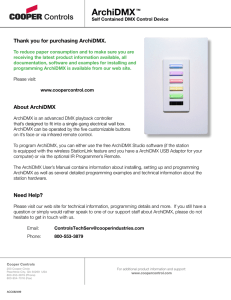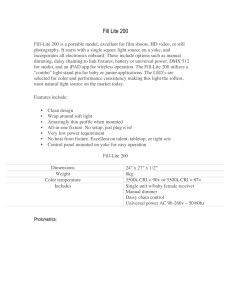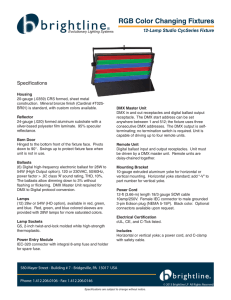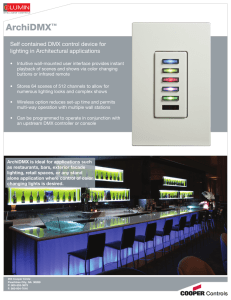Talent LP64LED PAR 64 DMX Light Manual
advertisement
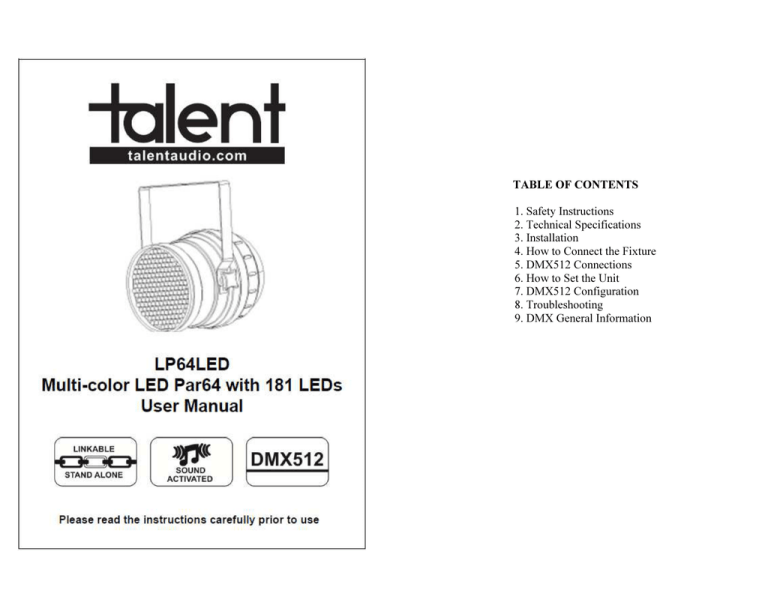
TABLE OF CONTENTS 1. Safety Instructions 2. Technical Specifications 3. Installation 4. How to Connect the Fixture 5. DMX512 Connections 6. How to Set the Unit 7. DMX512 Configuration 8. Troubleshooting 9. DMX General Information 1. Safety Instructions 2. Technical Specifications • Please keep this User Manual for future consultation. If you sell the fixture, be sure to include this instruction booklet to ensure proper maintenance and use. • Unpack and check carefully for transportation damage before using the fixture. • Before operating, ensure that the power supply voltage and frequency match the power of your electrical system. • It's important to connect the yellow/green conductor to ground to avoid electric shock. • Disconnect main power before servicing and maintenance. • Use a safety cable when permanently mounting this fixture. Always handle the fixture with care. • Maximum ambient temperature is 104° F. • In the event of a serious operating problem, stop using the fixture immediately. Please contact the dealer from whom you purchased the fixture, the nearest authorized technical repair facility, or Talent Sound & Lighting directly. • Do not connect the device to any dimmer pack. • Do not touch exposed wires during use, as there might be a hazard of electrical shock. • To prevent or reduce the risk of electrical shock or fire, do not expose the fixture to rain or moisture. • The fixture must be replaced if there is visible damage to the housing. • Do not look directly at the LED light beam while the fixture is on. • DMX channels: 3/5/7 selectable via digital display • 181 Ultra Bright 10 mm LEDs (Red: 49, Green: 72, Blue: 60) • 125 Static Colors/Dimmer/Strobe/Fade/Jump • Auto, sound active, DMX, and master/slave modes • Internal programs with sound activation • 3-pin XLR in/out sockets for DMX control • RGB color mixing • Beam angle: ±20° • Power consumption: 20 watts • Dimension: 9.25" diameter x 11.81" long • Weight: 3.52 lbs. Warning: Please read the instructions carefully. They include important information about installation, operation, and maintenance. Do not connect more than 32 units in series (daisy-chaining) on a single power circuit. Caution: There are no user serviceable parts inside the fixture. Do not open the housing or attempt any repairs yourself. In the unlikely situation your unit may require service, please contact your dealer or Talent Sound & Lighting. 3. Installation The unit should be mounted via its screw holes on its bracket. Always ensure that the unit is installed to avoid vibration while operating. Always ensure that the structure to which you are attaching the unit is secure and is able to support a weight of 10x this fixture's weight (35.2 lbs.) Always use a safety cable that can hold 12x the weight of the fixture. 4. How to Connect the Fixture 3-Pin and 5-Pin XLR DMX Connectors: Some manufactures use 5-pin XLR connectors for data transmission in place of 3-pin. 5-pin XLR fixtures may be implemented in a 3-pin XLR DMX line. When inserting standard 5-pin XLR connectors into a 3-pin line, a cable adapter must be used. The chart below details the correct cable conversion. 5. DMX512 Connections 6. How to Set the Unit DMX512 is a widely used protocol for intelligent lighting control, with 512 available channels. Even if you do not wish to operate your Talent lighting fixture via an outboard DMX controller, utilizing the master/slave mode will still require unit-to-unit connection by proper DMX cables. 6.1 Control Panel Caution: Common microphone cables may be used to connect small numbers of DMX fixtures over short distances, but offer the risk of erratic operation. Use of correct DMX cables greatly reduces data errors caused by improper connection. 6.2 Main Functions • If you are using a controller with 5-pin DMX output, use a 5-pin to 3-pin adapter cable. • Connect fixtures together in a "daisy chain" by connecting the DMX output of the first fixture to the DMX input of the next fixture. This cable cannot be branched or split by a "Y" cable. Inadequate or damaged cables, bad solder joints, or corroded connectors can easily distort the signal, cause errors, and shut down the system. Never allow contact between the data common/shield connection (XLR Pin 1) and the fixture's chassis/electrical ground. • The DMX output and input connectors are pass-through to maintain the DMX circuit if power to one of the units is disconnected. • On the last fixture, the DMX output should be terminated with a terminator to reduce signal errors. Solder a 120 ohm 1/4 watt resistor between pin 2 (DMX-) and pin 3 (DMX+) on a 3-pin XLR plug and connect it to the DMX output of the last fixture. Your Talent Sound & Lighting fixture may be operated as a stand-alone device that runs on pre-programmed routines or sound activation, in master/slave mode with other devices, or via an external DMX512 controller. In DMX mode it is configurable to be controlled by 3, 5, or 7 channels. Besides stand-alone operation, there are two main ways to control the fixture: A. Universal DMX control mode B. Master/Slave operation A. Universal DMX controller This fixture's DMX address can be set remotely by a universal DMX controller. First, you need to program two scenes into a chase, and then link the fixtures to the universal DMX controller. When you run the chase, the fixtures in the chain will set the series DMX address automatically. Each lighting fixture needs to have an address set when in DMX mode, to receive the data sent by the controller. The address number is between 0-511 (usually 0 & 1 are equal to 1). Please refer to the following diagram to set the address for the first four units. 7. DMX512 Configuration DMX Channel Values (3-Channel Mode) DMX Channel Values (5-Channel Mode) DMX Channel Values (7 Channel Mode) The numbers 1, 5, 9, and 13 indicate the starting address of each of the fixtures. B. Master/Slave operation The fixture allows you to link as many as 16 fixtures together and operate without a controller. In Master/Slave mode, the first fixture will control the others to give an automatic, sound activated, synchronized light show. This function is good for when you want an instant performance. The first, or master, fixture's DMX input will have nothing connected to it. Its output connects to the slave fixtures, which will be set in slave mode automatically. For additional details about DMX operation, please review Section 9. 8. Troubleshooting Notes Here are some troubleshooting suggestions: A. The fixture does not work, there is no light output. 1.) Check the connection of power and main fuse. 2.) Measure the voltage output on your power receptacle to ensure proper voltage. B. Fixture does not respond to DMX control. 1.) DMX LED should be on. If not, check DMX connectors and cables for proper connection. 2.) If DMX LED is on but not responding to a channel, check the DMX address settings and DMX polarity. 3.) If you have intermittent DMX signal problems, check the pins on the cable connectors and on the fixture. 4.) Try to use a different DMX controller. 5.) Interference may occur if DMX cables are run alongside high voltage cables. C. Fixture responds erratically to DMX control. 1.) You may have a break in the DMX cabling. Check the LED for the response of the master/ slave mode signal. 2.) Wrong DMX address in the fixture. Set the fixture to the proper address. 3.) Use of microphone cables for DMX connections can cause errors D. The fixture doesn't respond to sound. 1.) Make sure the fixture is not set to receive a DMX signal. 2.) Check the fixture's internal microphone by tapping the microphone.
